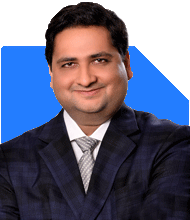How to adjust my investment portfolio with 20 lakhs education goal?
Ramalingam Kalirajan |10874 Answers |Ask -Follow
Mutual Funds, Financial Planning Expert - Answered on Nov 04, 2024
He has an MBA in finance from the University of Madras and is a certified financial planner.
He is the director and chief financial planner at Holistic Investment, a Chennai-based firm that offers financial planning and wealth management advice.... more

Hello Sir I am 38 years old. Currently investing in the following MFs. Parag Parikh Flexi cap 15K Mirae Asset large and mid cap 4K Axis Multi cap 2500 Bandhan Core Equity 5000 HDFC focused 30 5000 Quant Midcap 4000. Is there anything I need to change in my portfolio? I will need 20 lakhs per head for my children's education in 15 years. Thanks Hari
Here’s a comprehensive analysis to ensure a solid growth path for your investments:
Portfolio Assessment
Parag Parikh Flexi Cap: This fund provides exposure to both Indian and international equities, adding global diversification. This can help reduce risks related to the Indian market alone. With a long-term horizon, this fund can support capital appreciation, especially with its mix of large, mid, and small-cap companies.
Mirae Asset Large and Mid Cap: This fund balances the stability of large-cap stocks with the growth potential of mid-caps. This fund’s allocation adds moderate risk to your portfolio while targeting steady returns.
Axis Multi Cap: Multi-cap funds invest in companies across all market caps, giving you diversification. However, multi-cap funds can vary in returns due to their exposure to small and mid-cap stocks. You may consider if this allocation suits your risk tolerance.
Bandhan Core Equity: This is a large-cap-oriented fund, focusing on stability and consistent growth. With a long-term approach, large-cap funds can add resilience to your portfolio, especially when markets are volatile.
HDFC Focused 30: This is a focused fund with a limited number of high-conviction stocks, adding growth potential. However, focused funds can be riskier due to their limited holdings. This fund is suitable if you are comfortable with higher risk for better returns.
Quant Midcap: Midcap funds can offer substantial growth over the long term, though they are also more volatile. This allocation aligns with your long-term horizon and growth objectives, given your higher tolerance for risk.
Each fund you’ve chosen has its unique strengths, but let’s ensure optimal alignment with your objectives for your children’s education.
Recommended Portfolio Adjustments
Avoiding Overlap: Having multiple funds across similar categories may result in overlapping stocks, reducing diversification benefits. With three funds in the large-cap and multi-cap categories, you might face potential overlap. Reallocating towards diversified funds could optimise growth while reducing duplication.
Adding Actively Managed Funds: Since actively managed funds offer professional expertise in stock selection and sector allocation, they generally outperform index funds. If you’re considering index funds for their lower costs, be aware that they lack active monitoring and may perform poorly during market downturns. An actively managed fund will enhance returns, with a certified financial planner guiding you through potential risks.
Consider Regular Funds Over Direct: Direct funds appear cost-effective but require intensive market tracking. Regular funds, through a Certified Financial Planner (CFP), can help you maximise returns while managing risks. A professional can adjust your portfolio as per market trends, adding long-term value.
Increase SIP Allocation for Education Goal: You aim to build Rs 20 lakhs per child in 15 years. Increasing the SIP allocation towards funds with a good growth track record can help you meet this goal. Review your expected returns annually to ensure you’re on track.
Recommended Additions and Reallocations
Add a Balanced Advantage Fund: Balanced advantage funds adjust equity and debt exposure according to market conditions, offering stability during volatile periods. This will add flexibility and safety to your portfolio as your education goal approaches.
Introduce a Small-Cap Fund Carefully: If you can accept higher risk, adding a small-cap fund can bring long-term growth potential. Small-cap funds often outperform in bullish markets, supporting capital appreciation over long horizons.
Allocate More to Large-Cap and Mid-Cap Segments: Increasing exposure to large and mid-cap funds within your existing allocation could improve stability and growth potential. These funds are generally less volatile than small-cap funds, balancing your portfolio.
Tax Implications
Long-Term Capital Gains (LTCG): As per new rules, LTCG above Rs 1.25 lakh on equity funds will be taxed at 12.5%. Factor this tax into your planning to maximise net returns on your investments over the long term.
Short-Term Capital Gains (STCG): If any reallocation or adjustment occurs within three years, remember that STCG tax on equity funds is 20%. Regular monitoring with a Certified Financial Planner can help you make tax-efficient moves.
Ensuring Goal Achievement for Children’s Education
Calculate Regular SIP Adjustments: Since education costs are likely to rise, adjust your SIP contributions every few years. A Certified Financial Planner can help forecast the corpus needed based on inflation, keeping your goal on track.
Systematic Transfer Plan (STP) for Goal Alignment: Consider an STP five years before the goal deadline. Transferring funds from equity to safer debt funds gradually can protect your education corpus from market fluctuations.
Debt Allocation for Safety: Over time, allocate a portion to debt funds to protect your corpus. Debt funds help in risk reduction and ensure that funds are available when needed, especially in the last five years of your investment horizon.
Three-Yearly Review of the Portfolio
Review Market Trends: Since the economy undergoes shifts, reviewing your portfolio every three years with a Certified Financial Planner can help realign it. A balanced portfolio with the right mix of funds helps sustain returns even during downturns.
Track Performance: Funds’ performance can vary over time. Evaluate their returns regularly to see if they meet your expectations. Replace underperforming funds if required, as per guidance from your planner.
Final Insights
Aligning your portfolio with your children’s education goal is a thoughtful choice. Your current mix shows diversity, but minor adjustments can improve efficiency. By reallocating and ensuring active management, you’ll keep risks low and growth steady.
Focus on regular reviews, SIP adjustments, and tax-efficient strategies. This approach will help you reach your educational corpus goal effectively and prepare for unforeseen market changes.
Best Regards,
K. Ramalingam, MBA, CFP,
Chief Financial Planner,
www.holisticinvestment.in
https://www.youtube.com/@HolisticInvestment
You may like to see similar questions and answers below
Hardik Parikh | Answer |Ask -Follow
Tax, Mutual Fund Expert - Answered on Apr 20, 2023
Ramalingam Kalirajan |10874 Answers |Ask -Follow
Mutual Funds, Financial Planning Expert - Answered on May 29, 2024
Sanjeev Govila | Answer |Ask -Follow
Financial Planner - Answered on Jun 15, 2023
Ramalingam Kalirajan |10874 Answers |Ask -Follow
Mutual Funds, Financial Planning Expert - Answered on Apr 12, 2024
Ramalingam Kalirajan |10874 Answers |Ask -Follow
Mutual Funds, Financial Planning Expert - Answered on May 08, 2024
Mayank Chandel |2567 Answers |Ask -Follow
IIT-JEE, NEET-UG, SAT, CLAT, CA, CS Exam Expert - Answered on Dec 08, 2025
Mayank Chandel |2567 Answers |Ask -Follow
IIT-JEE, NEET-UG, SAT, CLAT, CA, CS Exam Expert - Answered on Dec 08, 2025
Mayank Chandel |2567 Answers |Ask -Follow
IIT-JEE, NEET-UG, SAT, CLAT, CA, CS Exam Expert - Answered on Dec 08, 2025
Mayank Chandel |2567 Answers |Ask -Follow
IIT-JEE, NEET-UG, SAT, CLAT, CA, CS Exam Expert - Answered on Dec 08, 2025
Anu Krishna |1746 Answers |Ask -Follow
Relationships Expert, Mind Coach - Answered on Dec 08, 2025
Ramalingam Kalirajan |10874 Answers |Ask -Follow
Mutual Funds, Financial Planning Expert - Answered on Dec 08, 2025
Samraat Jadhav |2499 Answers |Ask -Follow
Stock Market Expert - Answered on Dec 08, 2025
Ramalingam Kalirajan |10874 Answers |Ask -Follow
Mutual Funds, Financial Planning Expert - Answered on Dec 08, 2025
Radheshyam Zanwar |6737 Answers |Ask -Follow
MHT-CET, IIT-JEE, NEET-UG Expert - Answered on Dec 08, 2025
Nayagam P P |10852 Answers |Ask -Follow
Career Counsellor - Answered on Dec 07, 2025

Research Career Prospects: IISc, IITs, and Beyond: For research-oriented careers, the Integrated M.Sc Physics program at Amrita provides an exceptional foundation. Amrita's curriculum specifically aligns with GATE and UGC-NET examination syllabi, and the institution emphasizes early research engagement. The faculty at Amrita actively publish research in Scopus-indexed journals, with over 60 publications in international venues within the past five years, exposing you to active research environments.
To pursue research at premier institutions like IISc, you would typically follow the PhD pathway. IISc accepts M.Sc graduates through their Integrated PhD programs, and with your Amrita M.Sc, you're eligible to apply. You'll need to qualify the relevant entrance examinations, and your integrated program's emphasis on research fundamentals provides strong preparation. The final year of your Integrated M.Sc is intentionally structured to be nearly free of classroom commitments, enabling engagement with research projects at institutes like IISc, IITs, and National Labs. According to Amrita's data, over 80% of M.Sc Physics students secured internship offers from reputed institutions during academic year 2019-20, directly facilitating research career transitions.
Placement and Direct Employment Opportunities: Amrita University boasts a comprehensive placement ecosystem with strong corporate and government sector connections. According to NIRF placement data for the Amrita Integrated M.Sc program (5-year), the median salary in 2023-24 stood at ?7.2 LPA with approximately 57% placement rate. However, these figures reflect general placement trends; physics graduates often secure higher packages in specialized technical roles. Many graduates join software companies like Infosys (with early offers), Google, and PayPal, where their strong analytical and computational skills command competitive compensation packages ranging from ?8-15 LPA for entry-level positions.
The Department of Corporate and Industrial Relations at Amrita provides intensive three-semester life skills training covering linguistic competence, data interpretation, group discussions, and interview techniques. This structured placement support significantly enhances your employability in both government and private sectors.
Government Sector Opportunities: UPSC, BARC, DRDO, and ISRO: Your M.Sc Physics degree opens multiple avenues for prestigious government employment. UPSC Geophysicist examinations explicitly list M.Sc Physics or Applied Physics as qualifying degrees, enabling you to compete for Group A positions in the Geological Survey of India and Central Ground Water Board. The age limit for geophysicist positions is 32 years (with relaxation for reserved categories), and the exam comprises preliminary, main, and interview stages.
BARC (Bhabha Atomic Research Centre) actively recruits M.Sc Physics graduates as Scientific Officers and Research Fellows. Recruitment occurs through the BARC Online Test or GATE scores, with positions in nuclear science, radiation protection, and atomic research. BARC Summer Internship programs are available, offering ?5,000-?10,000 monthly stipends with opportunity for future scientist recruitment.
DRDO (Defense Research and Development Organization) recruits M.Sc Physics graduates through CEPTAM examinations or GATE scores for roles involving defense technology, weapon systems, and laser physics research. ISRO (Indian Space Research Organisation) regularly advertises scientist/engineer positions through competitive recruitment for candidates with strong physics backgrounds, offering opportunities in satellite technology and space science applications.
Other significant employers include the Indian Meteorological Department (IMD) recruiting as scientific officers, and NPCIL (Nuclear Power Corporation of India Limited), offering stable government service with competitive compensation packages exceeding ?8-12 LPA for scientists.
Alternate Career Pathways: UPSC, CDS, and AFCAT: UPSC Civil Services (IFS - Indian Forest Service): M.Sc Physics graduates qualify for UPSC Civil Services examinations, with the forest service offering opportunities for science-based administrative roles with potential to reach senior government positions.
CDS/AFCAT (Armed Forces): While AFCAT meteorology branches specifically require "B.Sc with Maths & Physics with 60% minimum marks," the technical branches (Aeronautical Engineering and Ground Duty Technical roles) require graduation/integrated postgraduation in Engineering/Technology. An M.Sc Physics integrates well with technical qualifications, though you would need engineering background for direct officer entry. However, you remain eligible for specialized technical interviews if applying through alternate defence channels.
UGC-NET Examination: This pathway leads to Assistant Professor positions in central universities and colleges across India. NET-qualified candidates receive scholarships of ?31,000/month for 2-year JRF positions with PhD pursuit, transitioning to Assistant Professor salaries of ?41,000/month in government institutions. This route provides long-term academic career security with research opportunities.
Private Sector Technical Roles
M.Sc Physics graduates are increasingly valued in data science, software engineering, and technical consulting. Companies actively recruit physics graduates for software development, where strong problem-solving and logical reasoning translate to competitive packages of ?10-20 LPA. Specialized domains including quantum computing development, financial modeling, and scientific computing offer premium compensation. Your minor in Scientific Computing makes you particularly attractive to technology companies requiring computational expertise.
International Opportunities and Higher Studies Abroad
An M.Sc from Amrita facilitates admission to PhD programs at international institutions. German universities offer tuition-free or low-fee MSc Physics programs (2 years) with scholarships like DAAD providing €850+ monthly stipends. US universities accept M.Sc graduates directly for PhD positions with full funding (tuition coverage + stipend). These pathways require GRE scores and strong Statement of Purpose articulating research interests. Research collaboration opportunities exist with Max Planck Institute (Germany) and CalTech Summer Research Program (USA), both welcoming Indian M.Sc students.
Essential Skills and Certifications to Develop Immediately: Programming Languages: Start learning Python immediately—it's universally used in research and industry. Dedicate 2-3 hours weekly to data analysis, scientific computing libraries (NumPy, SciPy, Pandas), and machine learning fundamentals. MATLAB is equally critical for physics applications, particularly numerical simulations and data visualization. Aim to complete MATLAB certification courses within your first year.
Research Tools: Learn Git/version control, LaTeX for scientific documentation, and data analysis frameworks. These skills are indispensable for publishing research papers and collaborating on projects.
Certifications Worth Pursuing: (1) MATLAB Certification (DIYguru or MathWorks official courses) (2) Python for Data Science (complete certificate programs from platforms like Coursera) (3) Machine Learning Fundamentals (for expanding technical versatility) & (4) Scientific Communication and Technical Writing (develop through departmental workshops)
Strategic Internship Planning: Leverage Amrita's research connections systematically. In your third year, apply to BARC Summer Internship, IISER Internships, TIFR Summer Fellowships, and IIT Internship programs (like IIT Kanpur SURGE). These expose you to frontier research while establishing connections for future PhD or scientist recruitment. Target 2-3 research internships across different specializations to develop versatility.
TO SUM UP, Your Integrated M.Sc Physics degree from Amrita positions you exceptionally well for competitive research careers at IISc/IITs, prestigious government scientist roles at BARC/DRDO/ISRO, and international PhD opportunities. The program's scientific computing emphasis differentiates you in the job market. Immediate priorities: (1) Master Python and MATLAB within the first two years; (2) Engage in research projects starting year 2-3; (3) Target internships at premiere research institutions; (4) Prepare GATE while completing your degree for maximum flexibility in recruitment; (5) Consider UGC-NET for long-term academic stability. Your career trajectory will ultimately depend on developing strong research fundamentals, demonstrating consistent excellence in specialization areas, and strategically selecting internship and research opportunities. The rigorous Amrita program combined with disciplined skill development positions you for exceptional career success across multiple sectors. Choose the most suitable option for you out of the various options available mentioned above. All the BEST for Your Prosperous Future!
Follow RediffGURUS to Know More on 'Careers | Money | Health | Relationships'.





























